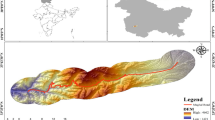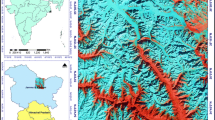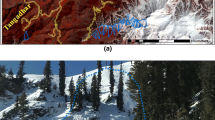Abstract
Snow avalanches are one of the most frequent natural hazards in high mountain regions. In this study, a map of the susceptibility of the Šar Mountains to snow avalanches was determined. The study area is located in the southern part of Serbia, which has the Status of a National park. Geographic information systems (GIS) and remote sensing are used to analysis and cartographical presentation of nine the most important elements of natural conditions which have an influence on avalanche development. Then, by applying the best-worst method (BWM) for each of the criteria was given a weighting coefficient depending on its importance for the avalanche occurrence. A synthetic map of snow avalanche susceptibility was created by processing geospatial data in the GIS software. The obtained results show that high susceptibility covers 16.9% of the territory, while 10.7% of the total area is very highly susceptible. The final results may be useful to decision-makers, local self-governments, emergency management services, and mountaineering services to mitigate human and material losses from snow avalanches. This study is the first to use the BWM methodology for snow avalanche hazard analysis.
Access this chapter
Tax calculation will be finalised at checkout
Purchases are for personal use only
Similar content being viewed by others
References
Bulajić, ĐB., Bajić, S., & Stojnić, N. (2018). The effects of geological surroundings on earthquake-induced snow avalanche prone areas in the Kopaonik region. Cold Regions Science and Technology, 149, 29–45. https://doi.org/10.1016/j.coldregions.2018.02.005
Wen, H., Wu, X., Liao, X., Wang, D., Huang, K., & Wünnemann, B. (2022). Application of machine learning methods for snow avalanche susceptibility mapping in the Parlung Tsangpo catchment, southeastern Qinghai-Tibet Plateau. Cold Regions Science and Technology, 198, 103535. https://doi.org/10.1016/j.coldregions.2022.103535
Gorynina, O., & Bartelt, P. (2023). Powder snow avalanche impact on hanging cables. International Journal of Impact Engineering, 173, 104422. https://doi.org/10.1016/j.ijimpeng.2022.104422
European Avalanche Warning Services: EAWS, https://www.avalanches.org/. Accessed 2023/02/21.
Ancey, C., Jóhannesson, T., Bakkehøi, S., Lied, K., Birkeland, K., Nishimura, K., Decker, R., Pudasaini, S.P., Hutter, K., Schaerer, P., Issler, D., & Sokratov, S. (2005). Some notes on the history of snow and avalanche research in Europe, Asia and America. Ice, 3–11
Rahmati, O., Ghorbanzadeh, O., Teimurian, T., Mohammadi, F., Tiefenbacher, J. P., Falah, F., Pirasteh, S., Ngo, P.-T.T., & Bui, D. T. (2019). Spatial modeling of snow avalanche using machine learning models and geo-environmental factors: comparison of effectiveness in two mountain regions. Remote Sensing, 11, 2995. https://doi.org/10.3390/rs11242995
Akay, H. (2021). Spatial modeling of snow avalanche susceptibility using hybrid and ensemble machine learning techniques. CATENA, 206, 105524. https://doi.org/10.1016/j.catena.2021.105524
Yariyan, P., Avand, M., Abbaspour, A. R., Karami, M., & Tiefenbacher, P. J. (2020). GIS-based spatial modeling of snow avalanches using four novel ensemble models. Science of The Total Environment, 745, 141008. https://doi.org/10.1016/j.scitotenv.2020.141008
Zaman, Q., Khan, S. N. (2020) The application of geographic information system (GIS) and remote sensing in quantifying snow cover and precipitation in Kabul Basin. Geosfera Indonesia, 5: 80–91. https://doi.org/10.19184/geosi.v5i1.14896
Bühler, Y., Von Rickenbach, D., Stoffel, A., Margreth, S., Stoffel, L., & Christen, M. (2018). Automated snow avalanche release area delineation—Validation of existing algorithms and proposition of a new object-based approach for large-scale hazard indication mapping. Natural Hazards and Earth System Sciences, 18, 3235–3251. https://doi.org/10.5194/nhess-18-3235-2018
Hao, J., Mind’je, R., Liu, Y., Huang, F., Zhou, H., Li, L. (2021). Characteristics and hazards of different snow avalanche types in a continental snow climate region in the Central Tianshan mountains. Journal of Arid Land, 13: 317–331. https://doi.org/10.1007/s40333-021-0058-5
Košová, V., Molokáč, M., Čech, V., & Jesenský, M. (2022). Avalanche hazard modelling within the Kráľova Hoľa area in the low Tatra mountains in Slovakia. Land, 11, 766. https://doi.org/10.3390/land11060766
Tabarestani, E. S., & Afzalimehr, H. (2021). Artificial neural network and multi-criteria decision-making models for flood simulation in GIS: Mazandaran Province, Iran. Stochastic Environmental Research and Risk Assessment, 35, 2439–2457. https://doi.org/10.1007/s00477-021-01997-z
Durlević, U., Novković, I., Lukić, T., Valjarević, A., Samardžić, I., Krstić, F., Batoćanin, N., Mijatov, M., & Ćurić, V. (2021). Multihazard susceptibility assessment: A case study—Municipality of Štrpce (Southern Serbia). Open Geosciences, 13(1), 1414–1431. https://doi.org/10.1515/geo-2020-0314
Hadian, S., Afzalimehr, H., Soltani, N., Tabarestani, E. S., Karakouzian, M., & Nazari-Sharabian, M. (2022). Determining flood zonation maps, using new ensembles of multi-criteria decision-making, bivariate statistics, and artificial neural network. Water, 14, 1721. https://doi.org/10.3390/w14111721
Selcuk, L. (2013). An avalanche hazard model for Bitlis Province, Turkey, using GIS based multicriteria decision analysis. Turkish Journal of Earth Sciences, 22(4), 2. https://doi.org/10.3906/yer-1201-10
Kumar, S., & Srivastava, P. K., Snehmani.: Geospatial modelling and mapping of snow avalanche susceptibility. Journal of the Indian Society of Remote Sensing, 46(1): 109–119 (2018). https://doi.org/10.1007/s12524-017-0672-z
Nasery, S., & Kalkan, K. (2021). Snow avalanche risk mapping using GIS-based multi-criteria decision analysis: The case of Van, Turkey. Arabian Journal of Geosciences, 14, 782. https://doi.org/10.1007/s12517-021-07112-4
Varol, N. (2022). Avalanche susceptibility mapping with the use of frequency ratio, fuzzy and classical analytical hierarchy process for Uzungol area, Turkey. Cold Regions Science and Technology, 194, 103439. https://doi.org/10.1016/j.coldregions.2021.103439
Durlević, U., Valjarević, A., Novković, I., Ćurčić, N.B., Smiljić, M., Morar, C., Stoica, A., Barišić, D., & Lukić, T. (2022). GIS-based spatial modeling of snow avalanches using analytic hierarchy process. A case study of the Šar Mountains, Serbia. Atmosphere, 13: 1229. https://doi.org/10.3390/atmos13081229
Milevski, I., Dragićević, S., & Zorn, M. (2019). Statistical and expert-based landslide susceptibility modeling on a national scale applied to North Macedonia. Open Geosciences, 11(1), 750–764. https://doi.org/10.1515/geo-2019-0059
Novkovic, I., Markovic, G. B., Lukic, D., Dragicevic, S., Milosevic, M., Djurdjic, S., Samardzic, I., Lezaic, T., & Tadic, M. (2021). GIS-based forest fire susceptibility zonation with IoT sensor network support, case study—Nature park Golija, Serbia. Sensors, 21, 6520. https://doi.org/10.3390/s21196520
Gulan, L., Stajic, J. M., Zeremski, T., Durlević, U., & Valjarević, A. (2022). Radionuclides and metals in the parks of the city of Belgrade, Serbia: Spatial distribution and health risk assessment. Forests, 13, 1648. https://doi.org/10.3390/f13101648
Srejić, T., Manojlović, S., Sibinović, M., Bajat, B., Novković, I., Milošević, M. V., Carević, I., Todosijević, M., & Sedlak, M. G. (2023). Agricultural land use changes as a driving force of soil erosion in the Velika Morava river basin, Serbia. Agriculture, 13, 779. https://doi.org/10.3390/agriculture13040778
Arumugam, T., Ramachandran, S., Kinattinkara, S., Velusamy, S., Snehmani, Shanmugamoorthy, M., & Shanmugavadivel, S. (2022). Bayesian networks and intelligence technology applied to climate change: An application of fuzzy logic based simulation in avalanche simulation risk assessment using GIS in a Western Himalayan region. Urban Climate, 45: 101272. https://doi.org/10.1016/j.uclim.2022.101272
Yariyan, P., Omidvar, E., Karami, M., Cerdà, A., Pham, B. Q., & Tiefenbacher, P. J. (2022). Evaluating novel hybrid models based on GIS for snow avalanche susceptibility mapping: A comparative study. Cold Regions Science and Technology, 194, 103453. https://doi.org/10.1016/j.coldregions.2021.103453
Iban, M. C., & Bilgilioglu, S. S. (2023). Snow avalanche susceptibility mapping using novel tree-based machine learning algorithms (XGBoost, NGBoost, and LightGBM) with eXplainable Artificial Intelligence (XAI) approach. Stochastic Environmental Research and Risk Assessment. https://doi.org/10.1007/s00477-023-02392-6
Menković, L., & Milivojević, M. (2021). Glacial morphology of the Šara Mountains. Bulletin of the Serbian Geographical Society, 101, 1–29. https://doi.org/10.2298/GSGD2101001M
Valjarević, A., Filipović, D., Milanović, M., & Valjarević, D. (2020). New updated world maps of sea-surface salinity. Pure and Applied Geophysics, 177, 2977–2992. https://doi.org/10.1007/s00024-019-02404-z
Rezaei, J. (2016). Best-worst multi-criteria decision-making method: Some properties and a linear model. Omega, 64, 126–130. https://doi.org/10.1016/j.omega.2015.12.001
Rezaei, J. (2015). Best-worst multi-criteria decision-making method. Omega, 53, 49–57. https://doi.org/10.1016/j.omega.2014.11.009
Liang, F., Brunelli, M., & Rezaei, J. (2020). Consistency issues in the best worst method: Measurements and thresholds. Omega, 96, 102175. https://doi.org/10.1016/j.omega.2019.102175
Makarevic, M., & Stavrou, S.: Location selection of a manufacturing unit using BWM and ELECTRE III. Journal of Supply Chain Management Science, 3(3–4): 113–130. https://doi.org/10.18757/jscms.2022.6856
Ahmadi, B. H., Kusi-Sarpong, S., & Rezaei, J. (2017). Assessing the social sustainability of supply chains using Best Worst Method. Resources, Conservation and Recycling, 126, 99–106. https://doi.org/10.1016/j.resconrec.2017.07.020
Sentinel Hub, EO Browser, https://www.sentinel-hub.com/explore/eobrowser/. Accessed 2023/02/26.
Riggs, G., Hall, D., & Salomonson, V. (1994). A snow index for the Landsat thematic mapper and moderate resolution imaging spectroradiometer. In Proceedings of the IGARSS’ 94–1994 IEEE International Geoscience and Remote Sensing Symposium (pp. 1942–1944). Pasadena, CA, USA: Institute of Electrical and Electronics Engineers. https://doi.org/10.1109/IGARSS.1994.399618
Stojković, S., Marković, D., Durlević, U. (2023). Snow cover estimation using sentinel-2 high spatial resolution data. A case study: National Park Šar Planina (Serbia). In N. Ademović, E. Mujčić, M. Mulić, J. Kevrić, Z. Akšamija (Eds.), Advanced technologies, systems, and applications VII. IAT 2022. Lecture notes in networks and systems (Vol. 539, pp. 507–519). Cham: Springer. https://doi.org/10.1007/978-3-031-17697-5_39
Schweizer, J., Bartelt, P., Herwijnen, & V.A. (2021). Chapter 12—Snow avalanches. In W. Haeberli, & C. Whiteman (Eds.), Hazards and disasters series, snow and ice-related hazards, risks, and disasters (2nd ed., pp. 377–416). Elsevier. https://doi.org/10.1016/C2018-0-00970-6
The Alaska Satellite Facility: ASF, https://asf.alaska.edu/. Accessed 2023/02/26.
Rouse, W. J., Haas, H. R., Schell, A. J., Deering, W. D. (1974). Monitoring vegetation systems in the Great Plains with ERTS. In Proceedings of the 3rd earth resources technology satellite-1 symposium (pp. 309–317). Washington, DC, USA: Goddard Space Flight Center.
Tucker, C. J. (1979). Red and photographic infrared linear combinations for monitoring vegetation. Remote Sensing of Environment, 8(2), 127–150. https://doi.org/10.1016/0034-4257(79)90013-0
Choubin, B., Borji, M., Mosavi, A., Hosseini, S. F., Singh, P. V., & Shamshirband, S. (2019). Snow avalanche hazard prediction using machine learning methods. Journal of Hydrology, 577, 123929. https://doi.org/10.1016/j.jhydrol.2019.123929
Živković, N. (2009). Average annual and seasonal river runoff in Serbia (In Serbian). University of Belgrade, Belgrade, Serbia.
Zaragozi, B., Rodriguez-Sala, J., Rabasa, A., Ramón, A., & Olcina, J. (2013). A data driven study of relationships between relief and farmland abandonment in a Mediterranean region. WIT Transactions on Ecology and the Environment, 175, 219–230. https://doi.org/10.2495/ECO130191
Military Geographical Institute, https://www.topografskakarta.com/. Accessed 2023/02/26.
QGIS Geographic Information System v3.8.3 with GRASS 7.6.1. http://qgis.osgeo.org/. Accessed 2023/02/27.
Rezaei, J. (2020). A concentration ratio for non-linear best worst method. International Journal of Information Technology & Decision Making, 19(3), 891–907. https://doi.org/10.1142/S0219622020500170
Flickr, https://www.flickr.com/. Accessed 2023/03/11.
Blic, https://www.blic.rs/. Accessed 2023/03/11.
Mears and Wilbur, Engineering and Land Use Planning for Snow Avalanches, https://mearsandwilbur.com/index.html. Accessed 2023/03/06.
Brožová, N., Fischer, J. T., Bühler, Y., Bartelt, P., & Bebi, P. (2020). Determining forest parameters for avalanche simulation using remote sensing data. Cold Regions Science and Technology, 172, 102976. https://doi.org/10.1016/j.coldregions.2019.102976
WSL Institute for Snow and Avalanche Research SLF, https://www.slf.ch/en/index.html. Accessed 2023/03/06.
Rahimi, S., Hafezalkotob, A., Monavari, S. M., Hafezalkotob, A., & Rahimi, R. (2020). Sustainable landfill site selection for municipal solid waste based on a hybrid decision-making approach: Fuzzy group BWM-MULTIMOORA-GIS. Journal of Cleaner Production, 248, 119186. https://doi.org/10.1016/j.jclepro.2019.119186
Funding
The study was supported by the Ministry of Education, Science and Technological Development of the Republic of Serbia (Contract number 451–03–68/2022–14/200091).
Author information
Authors and Affiliations
Corresponding author
Editor information
Editors and Affiliations
Rights and permissions
Copyright information
© 2023 The Author(s), under exclusive license to Springer Nature Switzerland AG
About this paper
Cite this paper
Durlević, U. et al. (2023). Snow Avalanche Hazard Prediction Using the Best-Worst Method—Case Study: The Šar Mountains, Serbia. In: Rezaei, J., Brunelli, M., Mohammadi, M. (eds) Advances in Best-Worst Method. BWM 2023. Lecture Notes in Operations Research. Springer, Cham. https://doi.org/10.1007/978-3-031-40328-6_12
Download citation
DOI: https://doi.org/10.1007/978-3-031-40328-6_12
Published:
Publisher Name: Springer, Cham
Print ISBN: 978-3-031-40327-9
Online ISBN: 978-3-031-40328-6
eBook Packages: Business and ManagementBusiness and Management (R0)




